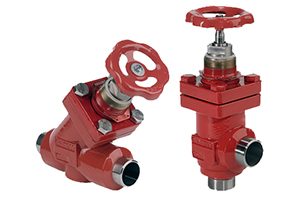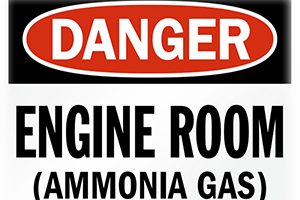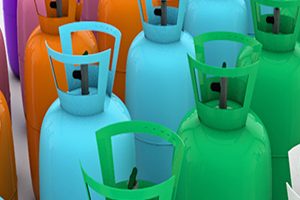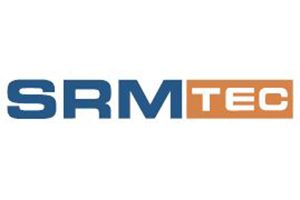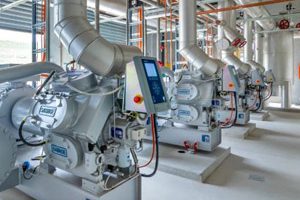Ammonia Evaporator for Cold Storage and Blast Freezer
Operating Temperature Range: +5°C to -50°C
Refrigeration Capacity Range: 3.5 kW to 221 kW
Ammonia Evaporator Coil
The ammonia evaporator coil is constructed using either steel or aluminum tubes, with aluminum fins of 0.5 mm thickness in both designs. For steel coil models, the tubes are hot-dip coated to a thickness of 120 microns, enhancing durability and preventing decay. The tubes are arranged in a triangular pattern, optimizing the heat transfer coefficient. To ensure reliability, all coils undergo pressure testing at 400 psi, verifying leak-free performance.
Evaporator Fin Spacing
Selecting the right fin spacing is crucial for ammonia evaporator performance, as it should align with the evaporator’s intended use, operating temperature, and humidity levels in the space. Proper fin spacing enhances the efficiency of defrost cycles, reduces defrost time, and maximizes the heat transfer coefficient with effective ventilation. The following general guidelines assist in determining the optimal fin spacing for specific ammonia evaporator applications.
Ammonia Evaporator Body
The ammonia evaporator body is constructed from pre-galvanized iron sheet with an electrostatic powder coating, ensuring durability and resistance to corrosion. The design of connections and bends maximizes strength and provides smooth, vibration-free operation. For specialized applications, the evaporator body can also be made from steel or aluminum sheet. Additionally, it includes both primary and secondary trays to prevent ice buildup during defrosting.
Air Circulation System
The evaporator’s air circulation system utilizes high-quality electro fans with IP55 protection and diameters ranging from 50 to 80 cm, proportional to the evaporator’s capacity. Fans are sourced from trusted brands like Ziehl-Abegg, EBM, or Rosenberg, operating at 380V/3Ph/50Hz. These fans include a thermistor system to regulate motor temperature, ensuring consistent performance and preventing overheating.
Defrost System Options
The evaporator offers several defrost system options, customizable based on needs:
– Hot Gas Defrost: Standard in design, featuring bottom tray coils and connections. This method is one of the fastest and most efficient defrosting options.
– Water Defrost: Available upon request, this system includes water distributor connections, a grid tray for even water distribution over the coil surface, and drainage connections. It’s a simple, cost-effective defrosting solution.
– Electrical Defrost: This optional system uses coated steel elements installed within the evaporator body and tray. Equipped with waterproof connections and a distribution box, this method is straightforward but incurs higher costs.
– Air Defrost: Ideal for evaporators operating at temperatures above +5°C, this system uses airflow from the evaporator fans to melt frost on the coil surface during defrosting.
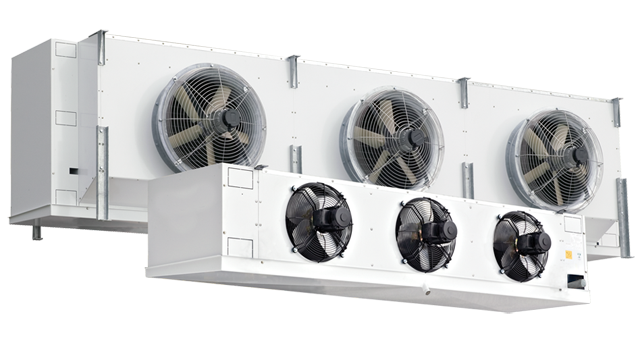

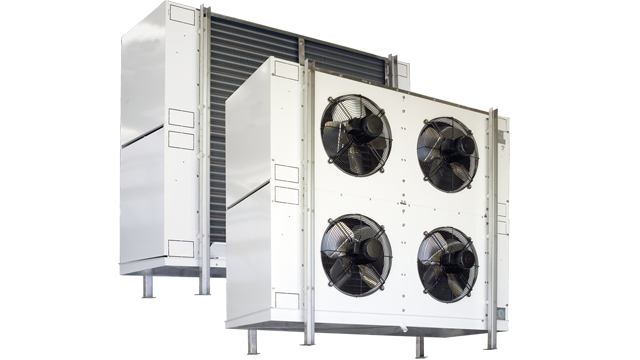
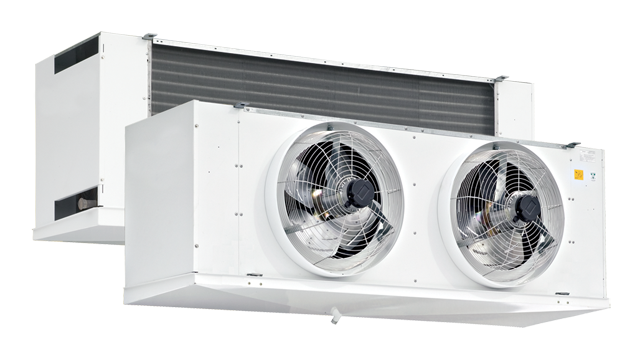
Introduction to Ammonia Evaporators
An ammonia evaporator is a heat exchanger used in ammonia refrigeration systems to vaporize liquid ammonia and absorb heat from the surrounding environment. Essential to industrial refrigeration and cold storage, these systems leverage ammonia for its excellent thermodynamic properties, high efficiency, and minimal environmental impact. Ammonia-based refrigeration is commonly applied in cooling, air conditioning, and cold storage applications.
Technical specifications of ammonia evaporator
In general, the technical specifications of the ammonia evaporator are as follows:
- Thermal capacity: determines the amount of ammonia evaporation and the cooling capability of the system (depending on the operating conditions).
- Working pressure: the pressure range designed for the evaporator (e.g. ammonia vaporization pressure 2 to 4 bar).
- Construction material: Ammonia evaporator coil material is usually made of steel, stainless steel, aluminum or corrosion-resistant alloys to withstand the chemical properties of ammonia.
- Refrigerant flow type: including gravity flow and pump circulation
- Refrigeration capacity: usually between 5 kW and 250 kW.
Features of Ammonia Evaporators
Key features of ammonia evaporators include:
– Designed and manufactured according to ASTM-249 standards for heat exchanger tubes
– Resistance to corrosive and chemical substances
– High efficiency due to the thermodynamic properties of ammonia
– Compatibility with ammonia refrigerant, supporting hot gas and water defrost methods
– Advanced fans with optimized surface designs and standard specifications
– Successful quality control testing for reliability
– Ideal for large-scale applications, such as industrial cold storage
Applications of Ammonia Evaporators
Ammonia evaporators are utilized across various industries, particularly in refrigeration and industrial cooling systems, owing to the favorable properties of ammonia and its high efficiency. Some of the primary applications include:
– Industrial Cold Rooms: Used for storing food and agricultural products requiring low temperatures.
– Dairy and Food Industries: Employed in cooling, freezing, and storing food products.
– Petrochemical and Chemical Industries: Essential for temperature control in processes sensitive to chemical reactions.
– Ice Factories: Utilized for ice production and storage.
– Beverage Factories: Applied for cooling beverages during the production process.
Purchasing an Ammonia Evaporator from Atlas Refrigeration
When considering the purchase of an ammonia evaporator, it’s crucial to focus on product quality and warranty, as any defect can lead to significant issues within your refrigeration cycle. To prevent complications and avoid extra costs, evaluate the seller’s credibility, product catalog, and technical specifications.
Atlas Refrigeration, with over 30 years of experience in manufacturing various cold storage solutions, including cold rooms, freezing tunnels, and chilling rooms, offers top-quality ammonia evaporators backed by a product guarantee. A key advantage of choosing Atlas Refrigeration is our commitment to after-sales service and support, along with complimentary expert consultations. Our team is dedicated to ensuring you select the best product at the right price to meet your needs.
Differences Between Steel and Stainless-Steel Evaporators
The table below outlines the key differences between stainless steel and iron evaporators. One of the most significant distinctions is their cost, with steel evaporators typically being less expensive.
| Stainless Steel Evaporators | Steel Evaporators | Feature |
| Very high, resistant to corrosion and rust | Good with galvanized coating | Corrosion resistance |
| Longer lifespan due to greater resistance | Shorter lifespan in corrosive environments | Longevity |
| More expensive than steel | Less expensive than steel | Cost |
| Thermal conductivity lower than steel | More thermal conductivity | Thermal conductivity |
| Lighter than steel | Heavier than stainless steel | Weight |
Summary
In conclusion, the ammonia evaporator is a crucial component of industrial refrigeration systems, essential for generating and maintaining low temperatures across various industries. Leveraging the unique properties of ammonia, these systems deliver effective and economical cooling solutions. From expansive cold storage facilities to the food and petrochemical sectors, ammonia evaporators are favored for their high efficiency and resistance to corrosion.
If you’re looking to optimize your refrigeration systems and harness the advantages of ammonia evaporators, contact us today. The expert team at Atlas Refrigeration is ready to assist you in selecting the best cooling equipment and solutions for your needs.
Yes, ammonia evaporators offer environmental advantages over other refrigerants, as ammonia has a lower impact on the ozone layer. However, proper management and adherence to safety standards are crucial to ensure their safe use.
To optimize the performance of an ammonia evaporator, it’s essential to properly select the equipment, conduct regular maintenance, and monitor working conditions such as temperature and pressure. Additionally, employing sensors and intelligent management systems can further enhance performance.
The selection of an ammonia evaporator type is influenced by several factors, including thermal load volume, the type of material to be cooled, environmental conditions, and operating and maintenance costs. Additionally, the specific application and the project’s unique requirements play a crucial role in this decision.
Related posts
Ammonia Evaporator
Ammonia Valves | Applications of Ammonia and Operating Conditions Ammonia valves play a crucial role in regulating the refrigerant within
Ammonia First Aid: Guidelines and Procedures Ammonia is not classified as a cumulative toxic substance. However, its strong and distinctive
Choosing Between Ammonia and Freon in Industrial Refrigeration Systems The decision between using ammonia or Freon in the refrigeration cycle
What Is Ammonia Screw Compressor? An ammonia screw compressor is a type of compressor used in industrial refrigeration systems to
Introduction to Ammonia Refrigeration Systems – Properties, Applications, and Equipment Overview Ammonia, with the chemical formula NH3 and the refrigerant
